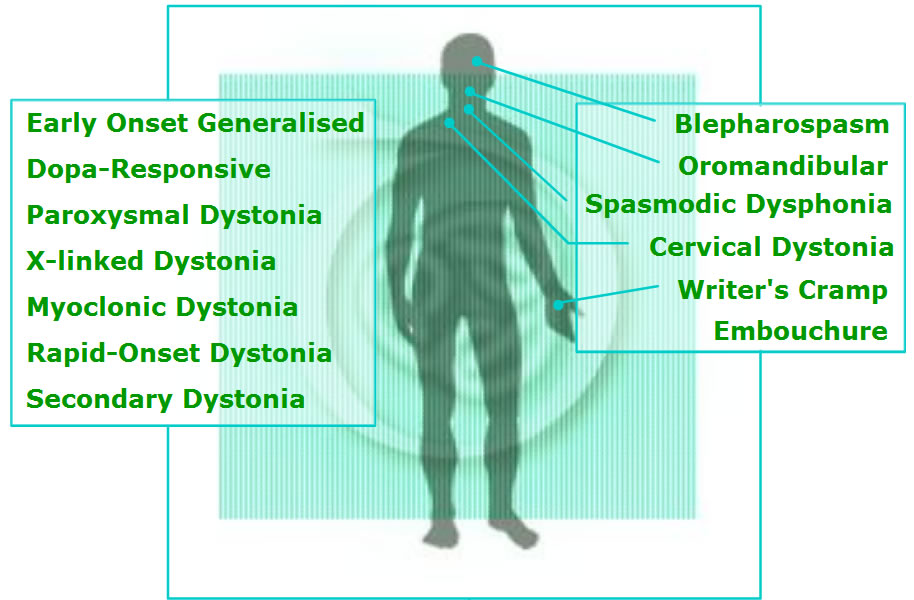Forms of Dystonia
Forms of Dystonia
Click section for more info

Early-onset generalised
Early-onset generalised
Early-onset generalised dystonia, the most common hereditary form of dystonia, is characterised by the twisting of the limbs, specifically the foot/leg or hand/arm. The spasms may spread to involve twisting contractions of other parts of the body. Find out more…
Dopa-Repsonsive
Dopa-Repsonsive
Dopa-Repsonsive Dystonia (DRD), a heredity form of dystonia, is characterised by progressive difficulty walking. Its symptoms may be similar to those of early-onset generalised dystonia. Find out more…
Paroxysmal Dystonia
Paroxysmal dyskinesias
Paroxysmal dyskinesias are episodic movement disorders in which abnormal movements are present only during attacks. The term paroxysmal indicates that symptoms are noticeable only at certain times. Find out more…
X-linked Dystonia
X-linked Dystonia
X-linked dystonia-parkinsonism or Lubag is a rare genetic form of dystonia found almost entirely among men from the Philippine Island of Panay. Find out more…
Myoclonic Dystonia
Myoclonic Dystonia
Myoclonic dystonia, a less common genetic form of dystonia, is characterised by rapid lightening-like movements (jerks) alone or in combination with the sustained muscular contractions and postures of dystonia. Find out more…
Rapid-Onset Dystonia
Rapid-Onset Dystonia
Rapid-Onset Dystonia Parkinsonism (RDP), a rare hereditary form of dystonia, is characterised by the abrupt onset of slowness of movement (parkinsonism) and dystonic symptoms. Find out more…
Secondary Dystonia
The various forms of dystonia can be classified into two broad groups: primary dystonias and secondary dystonias. Primary dystonias are largely genetic in origin whereas secondary dystonias result from apparent outside factors and are usually attributed to a specific cause, such as exposure to certain medications, trauma, toxins, infections, or stroke. Find out more…
Blepharospasm
Blepharospasm is a focal dystonia characterised by increased blinking and involuntary closing of the eyes. People with blepharospasm have normal vision. Visual disturbance is due solely to the forced closure of the eyelids. Find out more…
Oromandibular
Oromandibular Dystonia is a focal dystonia characterised by forceful contractions of the jaw and tongue, causing difficulty in opening and closing the mouth and often affecting chewing and speech. Find out more…
Spasmodic dysphonia
Spasmodic dysphonia, a focal form of dystonia, involves involuntary “spasms” of the vocal cords, causing interruptions of speech and affecting the voice quality. Find out more…
Cervical Dystonia
Cervical Dystonia, also known as spasmodic torticollis, is a focal dystonia characterised by neck muscles contracting involuntarily, causing abnormal movements and posture of the head and neck. Find out more…
Writer’s Cramp
Writer’s Cramp is a task-specific focal dystonia of the hand. Symptoms usually appear when a person is trying to do a task that requires fine motor movements. The symptoms may appear only during a particular type of movement, such as writing or playing the piano, but the dystonia may spread to affect many tasks. Find out more…
Embouchure
Embouchure dystonia is a term used to describe a type of dystonia that affects brass and woodwind players. The term embouchure refers to the adjustment of the mouth to fit the mouthpiece of a wind instrument. The anatomy of this form of dystonia includes muscles of the mouth, face, jaw, and tongue. Find out more…
